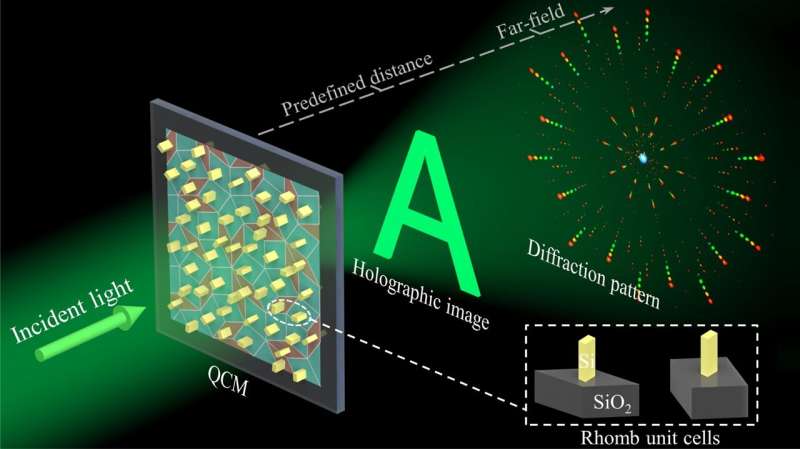This article has been reviewed according to Science X's editorial process and policies. Editors have highlighted the following attributes while ensuring the content's credibility:
fact-checked
peer-reviewed publication
trusted source
proofread
Scientists find quasicrystal metasurface projects holographic images and light patterns simultaneously

Scientists have advanced metasurface technology by developing a new design that simultaneously projects holographic images and creates special diffraction patterns with ten-fold rotation symmetry of quasicrystal. This ultra-thin material merges the unique properties of quasicrystals with light manipulation techniques.
Metasurfaces, already known for their ability to bend light in unusual ways, hold promise for a new generation of ultra-thin devices in areas like holographic displays, light switching, and even advanced security features.
Traditionally, metasurfaces rely on tiny structures called meta-atoms arranged in a regular grid. This new design breaks the mold by positioning these meta-atoms in a more complex, quasicrystal pattern. Quasicrystals, while ordered, lack repetitive structures. This innovative arrangement allows the metasurface to achieve two functionalities at once.
By manipulating the phase of light, the metasurface can be programmed to reconstruct an image at a specific distance, essentially generating holographic displays. Additionally, the arrangement of metaatoms in a quasicrystal pattern creates unique diffraction patterns of light visible in the far field.
This new design offers significant advantages over conventional metasurfaces. First, its multifunctional nature allows a single metasurface to perform two tasks simultaneously, simplifying device design. Second, the quasicrystal arrangement grants more precise control over light manipulation.
Quasicrystal metasurfaces have unique advantages over periodic arrangements. It can be designed by combining the global symmetry of metasurface with the local response of meta-atoms. As a result, additional functionality can be achieved.
These advancements pave the way for a new generation of ultra-thin devices with exciting possibilities. High-resolution, thin holographic displays could be created for various applications. Ultra-fast and efficient light-switching devices are also within reach.
Judiciously designed diffraction patterns with high-resolution holographic images could be created for 3D imaging and optical security. For example, this technology can promise advanced security features, such as diffractive elements used in anti-counterfeiting and secure communication.
Furthermore, such a phenomenon may provide a new perspective for revealing multi-substances of quasicrystals that possess special arrangements together with local optical response surpassing amplitude, through simultaneously detecting the wavefront and the diffraction patterns.
The findings are published in the journal eLight.
More information: Chi Xu et al, Quasicrystal metasurface for dual functionality of holography and diffraction generation, eLight (2024). DOI: 10.1186/s43593-024-00065-7
Journal information: eLight
Provided by Chinese Academy of Sciences



















